Lesson Two: The Russian Revolution
| Site: | MoodleHUB.ca 🍁 |
| Course: | Social 30-2 RVS |
| Book: | Lesson Two: The Russian Revolution |
| Printed by: | Guest user |
| Date: | Monday, 27 October 2025, 8:12 AM |
Description
1. Introduction
The Russian Revolution
Key Question: Is resistance to liberalism justified?
Duration: 3 blocks (80 mins each + homework)
As you learned in lesson two, Karl Marx was one of the most significant socialist thinkers, and he inspired socialist movements around the world. His works, especially The Communist Manifesto, greatly influenced the development of communist ideologies, even long after his death. Marx believed that through revolution people could move closer to a state of society called communism. According to Marx, communism is a classless society in which all people share in the production of goods and no government is needed.
During the 20th century, different forms of communism developed in different countries around the world based on different interpretations of Marxism. In this lesson you will learn about why and how communism developed in Russia.
2
2. Lesson 4.2.1 Tsarist Rule in Russia
Tsarist Rule in Russia
Tsar Nicholas II
Before 1917, Russia had been under the rule of absolute monarchs. The tsars*, the kings and queens of Russia, had ruled the country for hundreds of years with little concern for the needs of the citizens
of their country. The last Russian tsar, Nicholas II, could no longer fight the forces of nationalism and liberalism in his country. Political and economic change in Russia was inevitable.
*tsar is
sometimes also "czar".
Under the tsars, Russian society was divided into social and economic classes. Peasants worked the land (oppressed despite the abolition of serfdom), the Kulaks were wealthy farmers of the Ukraine, and the workers were in the growing industries of Russia.
Nicholas II had introduced some forms of liberalism to his absolute form of government. Liberal ideas had spread through Europe, and Russians were demanding similar changes. Nicholas II allowed for an elected Duma, which was a representative assembly. Although the Duma was an elected form of government, the tsar still had ultimate power and could disregard any decisions made by the Duma. Russians were angered that the tsar would not listen to their demands for more food, better working conditions, and better government.
Under the tsarist regime of Nicholas II, industry and farming were controlled mainly by royalty. For the vast majority of Russian citizens, life was difficult because they worked for wealthy landowners or factory owners who paid them very small salaries. As in Europe, these workers laboured long hours in unhealthy factories with very little chance of increased pay or improved working conditions. Very few peasant farmers owned land.
Nicholas II, the last tsar of Russia, was a weak tsar who ruled Russia in difficult times. Many factors led to the end of his rule:
-
Most of the Russian people had poor living and working conditions.
-
The spread of liberal ideas throughout Europe incited the Russian people toward change.
-
Nicholas' was a weak leader unable to listen to the Russian people.
-
Events such as Bloody Sunday showed his weak rule.
-
Nicholas' poor conduct of the Russian army during World War I resulted in huge death tolls and famine (starvation) causing rebellion among the Russian soldiers and people.
-
Nicholas' son's illness (hemophilia — a potentially fatal blood disorder) distracted the tsar from his duties.
-
Nicholas refused to share power with the Russian parliament, or Duma.
Bloody Sunday, 1905
In the late 19th and early 20th centuries, Russian industrial employees worked an average of eleven hours per day, six days a week. Conditions in the factories were extremely harsh, and the factory owners showed little concern for workers' health and safety. The workers attempted to form unions to help improve conditions, but the factory owners and the tsars resisted these attempts by the workers. In 1903, Father George Gapon formed the Assembly of Russian Workers, a union that promoted workers' rights.
1904 had been a bad year for Nicholas II's Russia. The war with Japan had gone very badly. Two Russian fleets had been destroyed, and a Russian army had been forced to surrender its only Pacific port at Vladivostok.
In addition, the year 1904 had been a bad one for Russian workers. Prices of basic goods and services had risen quickly, and wages declined by 20 per cent. When four members of the Assembly of Russian Workers were fired from an iron works factory, Father Gapon decided to take action. Under his leadership, more than 110 000 workers in St. Petersburg went on strike.
In an attempt to settle the dispute, Father Gapon decided to make a personal appeal to Nicholas II. He wrote a petition outlining the workers demands.
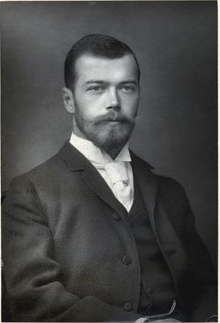
Tsar Nicholas II

Father Gapon

Bloody Sunday, 1905
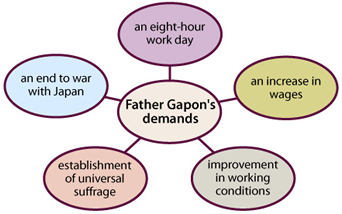
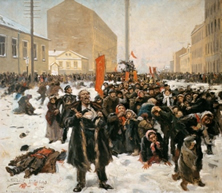
More than 150 000 people signed the petition. On January 22, 1905, Father Gapon led the unarmed demonstrators (workers) to the Winter Palace in St. Petersburg to present the petition to Tsar Nicholas II. Nicholas was not at the Winter Palace, and the guards did not know how to react to the demonstrators. In panic, the guards shot in the air. The demonstrators continued to advance and the soldier's panic grew. In desperation, the soldiers fired on the advancing crowd. More than 100 workers were killed, and 300 workers were wounded. This incident is known as Bloody Sunday because of the blood on the snow after the attack. It has been said that even if the tsar had been at the Winter Palace, he would not have listened to Father Gapon's demands anyway.
Bloody Sunday is known as the first step to the Russian Revolution of 1917. The hardships and inequalities that people experienced during this time and the spread of liberal values led to the uprising of the workers. Events such as Bloody Sunday were dramatic proof of the desire for social, political, and economic change.
3. Lesson 4.2.2 World War I
Please watch the following video explain World War I

Crash Course World History
World War I was a costly war for the tsarist dynasty both in resources and lives lost. Russian industry was not able to supply enough equipment to the army. The army generals were incompetent, especially after Nicholas II assumed command. Many soldiers deserted because they did not have enough ammunition, food, or clothing.
While Nicholas was busy with military issues on the Russian front, Tsarina Alexandra (Nicholas' wife) was left in control of the government in St. Petersburg. It was a costly mistake. Nicholas was far away from the centre of power, and his wife was not liked by the Russian people. Rasputin, a religious madman, had convinced Nicholas' wife that only he could save her sick son, Alexis, heir to Nicholas' throne. Gradually, Alexandra let Rasputin take control of the government, and he made many ill-conceived decisions. Thus, the Russian government was in chaos while the real leader, Nicholas II, was far away.
Unfortunately for Nicholas II, Russia was ready for a revolutionary change.
4. Lesson 4.2.3 The Russian Revolution
The Russian Revolution
During February 1917, in the streets the Russian people were rioting for food. The military refused to support the tsar's government and stop the rioting or control the people. Nicholas no longer had the support of the army or of his people. He had lost control of all Russian society. The Russian parliament (Duma) forced Nicholas to abdicate (give up control of the country) in February 1917. The Duma, or Russian parliament, took over from the tsar and governed Russia with a democratically-elected provisional government. However, the Duma's provisional government was of short duration.
The Duma's provisional government failed for several reasons:
-
It did not want to make changes quickly.
-
It was unable to satisfy the demands of all the groups that wanted changes.
-
It wanted to continue fighting in World War I, but the Russian people were very much opposed to continuing to fight in WWI. The people wanted peace.
Although outlawed, socialists had been active in Russia for many years. A socialist leader, Vladimir Lenin, saw the chance for a Marxist revolution in Russia.
5. Lesson 4.2.4 Leninism
Leninism
Karl Marx had expected the communist revolution to strike in the industrial heartlands of Britain, France, and Germany. However, these countries avoided a Marxist revolution by reforming classical liberalism into modern liberalism. The first successful communist revolution occurred, surprisingly, in Russia.
Bad leadership, shortages of food, and Russian losses to the Germans in World War I contributed to the downfall of Tsar Nicholas II. Among the various groups competing for power in Russia was a group led by Lenin called the Bolsheviks, an extremist socialist group. Lenin was a Marxist who saw in the turmoil of the Russian revolt an opportunity to form a communist government.
Vladimir Lenin, 1870-1924
Lenin came from a wealthy intellectual family. About 1890, Lenin encountered Marx's ideas and began his revolutionary activity, for which he was expelled from university. After being arrested and spending a year in prison, he was exiled from Russia. In 1917, he was smuggled back into Russia by the Germans with the hope that he would lead a revolution that would pull Russia from World War I. He led the Bolsheviks in the communist October Revolution, 1917, and seized power by force from the provisional government in Russia.
A popular Bolshevik slogan was "Peace! Land! Bread!"
-
Peace was about getting Russia out of World War I.
-
Land was about taking land from wealthy landowners and distributing it to the peasants.
-
Bread was about getting food to the people because they were starving due to WWI.
After Lenin was in control of Russia, he pulled Russia out of World War I.
He took Marxist ideology (Marxism) and put it into practice. Leninism is Marxism applied to the political and economic systems of Russia. Lenin overthrew the government of Russia, established an authoritarian dictatorship, and introduced socialist economic principles.
One of Lenin's major contributions to Marxism was the importance of the Communist Party. Whereas Marx believed the proletariat (fancy word for workers) would come collectively to realize the need for revolution, Lenin believed an elite group would have to rally the people. These elite revolutionaries would be members of the Communist Party.
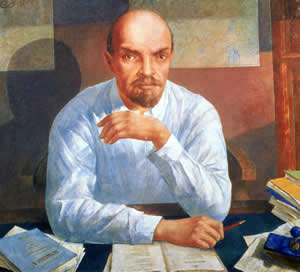
Vladimir Lenin, 1870-1924
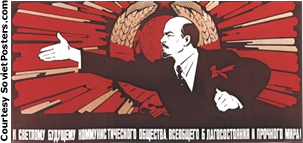
To the bright future of communist society, universal prosperity and enduring peace.
Lenin was the founder of the Communist Party and the Soviet Union
In the beginning, Lenin seized all the means of production in the name of the people. He took the land from the wealthy landowners and gave it to the peasants. He also took control of the railways, banks, and all foreign trade.
With that completed, Lenin faced the problem of rebuilding the economy. He pushed for organized control of production and distribution of goods. He called on the workers to increase productivity, to develop large scale industries, and to be more disciplined and efficient.
In the spring of 1918, those opposed to Lenin's policies started a civil war with the aid of forces from America, Britain, France, and Japan. This civil war led Lenin to impose a drastic policy known as war communism. Under this policy, peasants were forced to give up surplus crops to feed Lenin's Red Army. Factory workers were told where to work. Factories employing more than ten workers were nationalized; that is, they became the property of the government.
Lenin's communist Red Army was successful, but the cost was high. Millions of people were killed and millions more faced starvation. The economy was devastated. Most factories were not in working order, the railway system had collapsed, and there were shortages of materials everywhere.
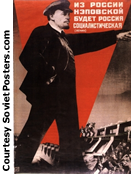
The New Economic Policy: Lenin's attempt to save the communist dream
The New Economic Policy (NEP)
Lenin saw the need for drastic action. He put into operation the New Economic Policy, or N.E.P. The plan called for for a temporary retreat from socialism and a return to some capitalist principles, such as individual incentive and profit-making.
Peasants were encouraged to grow more food. The surplus crops could be sold in private markets for a profit. Entrepreneurs were allowed on a small scale. Factories employing less than twenty workers were put back into private ownership.
Lenin saw these moves as only temporary setbacks to socialism. He kept government control of the large factories, heavy industry, banks, railways, and foreign trade.
By 1924, food and industrial production had risen dramatically. Unfortunately, in 1924, Lenin died and the Soviet Union was again thrown into turmoil.6. Conclusion
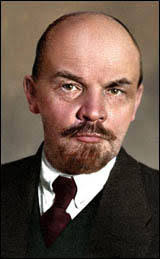
In 1922 the Union of Soviet Socialist Republics (the USSR or Soviet Union) was created with Vladimir Ilich Lenin as the first leader of the communist country. Under his leadership the people of the Soviet Union saw many positive changes:
- Land was redistributed to the people
- Factories were given to the workers so that they could make decisions about wages and and working conditions
- Men and women were considered equal and valuable contributors to society
- Art and music flourished as there were no longer restrictions on what one could create
Lenin's application of Marxist values had given many poor and working class people much more power over their lives than they had known under czarist rule. This came to an abrupt end after Lenin died from a stroke in 1924.